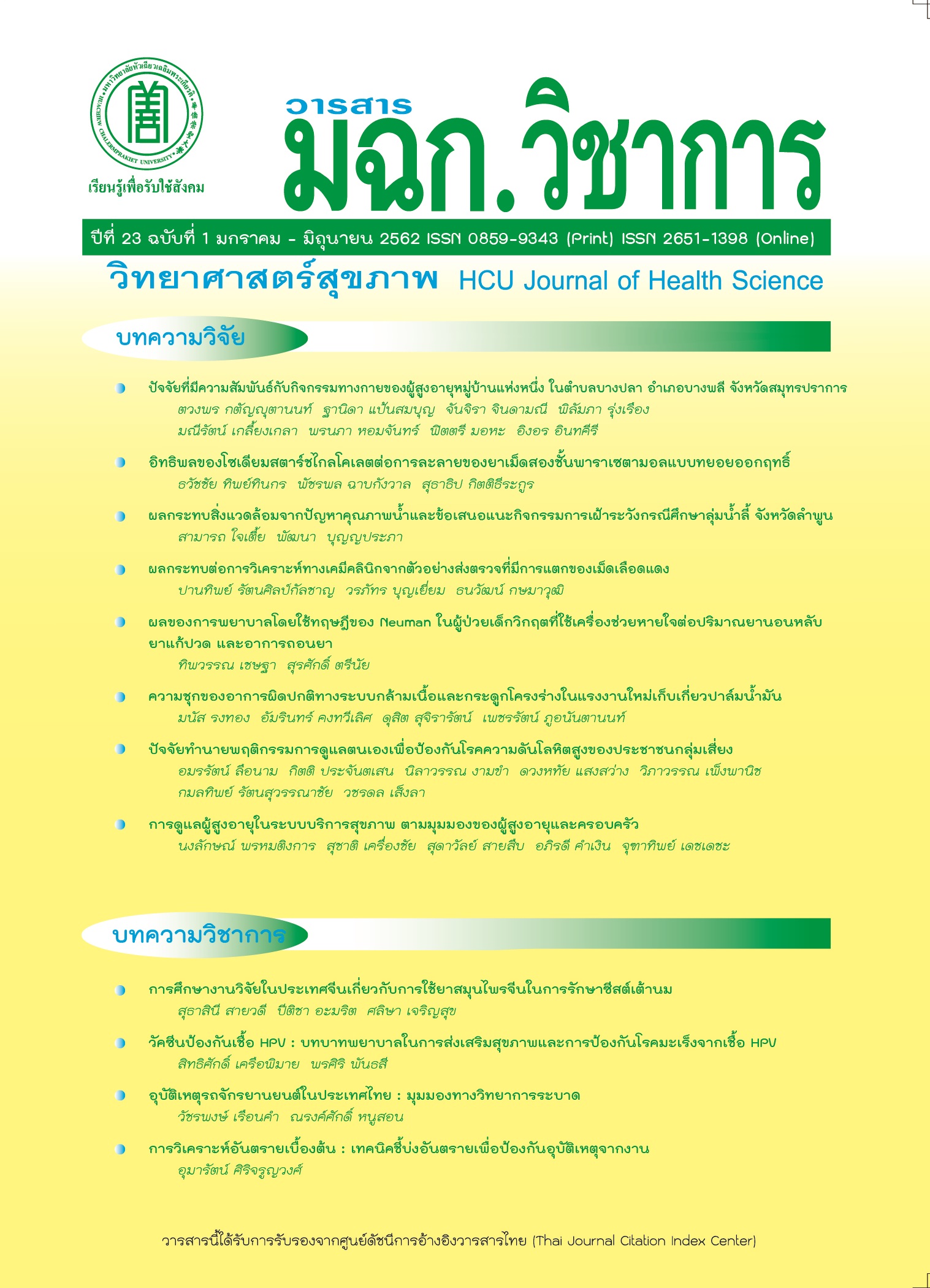Predictive Factors of Self-Care Behavior for Prevention of Hypertension among Population Group at Risk
Keywords:
Self-care behavior for prevention, hypertension, population group at riskAbstract
The aims of this study were to investigate the prevalence of self-care behavior for prevention of hypertension among population groups of at risk individuals aged over 35 years and its association in the private hospital. This cross-sectional study was conducted during January to May 2018 among 298 participants. A self-administered questionnaire was used to assess factors of self-care behavior for prevention of hypertension. As a predictive analysis, the multiple regression is used to explain the relationship between multiple factors of self-care behavior and prevention of hypertension
The result showed that most of the participants (±S.D; 3.22 ±0.21, 95%CI; 3.20-2.24), had a fair level of self-care behavior for prevention of hypertension. The results indicated that the employee status, bachelor’s degree attainment, perception of obstacles, received risk of disease, practical induction, and marital status of widow could be predictive factors of self-care behaviour for prevention of hypertension (Adj R2 =26.82).
Downloads
References
2. Wang H, Dwyer-Lindgren L, Lofgren KT, Rajaratnam JK, Marcus JR, Levin-Rector A, et al. Age-specific and sex-specific mortality in 187 countries, 1970–2010: A systematic analysis for the Global Burden of Disease Study 2010 The Lancet. 2012;380(9859):2071-94.
3. World Health Oranization. World Heath Statistics 2012 [Internet]. 2012 [cited 2018 Aug 18]. Available from: http://www.who.int/gho/publications/world_health_statistics/ EN_WHS2012_Full.pdf
4. Ministry of Public Health. Statistcs 2016 [Internet]. 2016 [cited 2018 Aug 18]. Available from: http://bps.moph.go.th/new_bps/sites/default/files/health_strategy2559.pdf
5. เวธกา กลิ่นวิชิต, พิสิษฐ์พิริยาพรรณ, พวงทอง อินใจ. การศึกษาภาวะเสี่ยงต่อการเป็นโรคเบาหวานและกลุ่มอาการเมตาบอลิค การรับรู้พฤติกรรมการส่งเสริมสุขภาพและ การสนับสนุนทางสังคมของนิสิตมหาวิทยาลัยบูรพา. การพยาบาลและการศึกษา. 2553;3(2):86-98.
6. กระทรวงสาธารณสุข. รายงานสรุปผลการคัดกรองโรคเบาหวานและความดันโลหิตในประชาชนอายุ 35 ปีขึ้นไป [อินเทอร์เน็ต]. 2558-2560 [เข้าถึงเมื่อ 4 สิงหาคม 2561]. เข้าถึงได้จาก: https://hdcservice.moph.go.th/hdc/reports/report.php?source=formated/screen_risk.php&cat_id=6966b0664b89805a484d7ac96c6edc48&id=6833128a5d76a6afcae3e4a6af0e718c
7. บุบผาชาติ ทีงาม, เยาวภา ติอัชสุวรรณ, ช่อทิพย์ บรมธนรัตน์. ปัจจัยที่มีผลต่อการปฏิบัติในการป้องกันโรคเบาหวานและโรคความดันโลหิตสูงของประชากรกลุ่มเสี่ยง ในเขตพื้นที่รับผิดชอบของสถานีอนามัยบ้านโพนม่วง อำเภอชุมพลบุรี จังหวัดสุรินทร์.วารสารวิจัยและพัฒนาระบบสุขภาพ. 2555;5(3):127-34.
8. เพชรรัตน์ เกิดดอนแฝก, บุญจันทร์ วงศ์สุนพรัตน์, อุมาพร อุดมทรัพยากุล, เฉลิมศรี นันทวรรณ. การรับรู้ความเสี่ยง ความเสี่ยงต่อการเกิดโรคเบาหวานตามเกณฑ์ และวิถีชีวิตที่ส่งเสริมสุขภาพในญาติสายตรงลำดับแรกของผู้ที่เป็นเบาหวาน. รามาธิบดีพยาบาลสาร. 2553;2(16):169-84.
9. อัจฉรา จินดาวัฒนวงศ์, นพวรรณ เปียซื่อ, พัชรินทร นินทจันทร์. ความสัมพันธ์ระหว่างการรับรู้ความเชื่อด้านสุขภาพกับพฤติกรรมการป้องกันโรคเบาหวานชนิดที่ 2 ในนักเรียน มัธยมศึกษาตอนปลาย. รามาธิบดีพยาบาลสาร. 2555;18(1):58-69.
10. Becker MH. The health belief model and sick role behavior. Health Educ Monogr.1974;2(4):409-19.
11. Rosenstock I, Stretcher V, Becker M. Social learning theory and the health belief method. Health Education Quarterly. 1988;13:73-92.
12. Cohen J. A power primer. Psychological Bulletin. 1992;112(1):155.
13. สมใจ จางวาง, เทพกร พิทยภินัน, นิรชร ชูติพัฒนะ. ปัจจัยที่มีความสัมพันธ์กับพฤติกรรมการดูแลตนเองเพื่อป้องกันโรคเบาหวานและโรคความดันโลหิตสูงของกลุ่มเสี่ยง. วารสารเครือข่ายวิทยาลัยพยาบาลและสาธารณสุขภาคใต้. 2559;3(1):110-28.
14. Warren-Findlow J, Seymour RB, Huber LRB. The association between self-efficacy and hypertension self-care activities among African American adults. Community Health. 2012;37(1):15-24.
15. Nothwehr F, Elmer P, Hannan P. Prevalence of health behaviors related to hypertension in three blood pressure treatment groups: the Minnesota Heart Health Program. Pre Med. 1994; 23(3):362-8.
16. Applegate WB, Pressel S, Wittes J, Luhr J, Shekelle RB, Camel GH, et al. Impact of the treatment of isolated systolic hypertension on behavioral variables results from the systolic hypertension in the elderly program. Arch Intern Med. 1994;154(19):2154-60.
17. ศุภรัชต์ ผาธรรม. รูปแบบการจัดการเพื่อการปรับเปลี่ยนพฤติกรรมการควบคุมระดับความดันโลหิตของผู้ป่วยโรคความดันโลหิตสูงในศูนย์สุขภาพชุมชนอำเภอศรีรัตนะ จังหวัดศรีสะเกษ [วิทยานิพนธ์].มหาสารคาม: มหาวิทยาลัยมหาสารคาม; 2551.
18. Tang TS, Brown MB, Funnell MM, Anderson RM. Social support, quality of life, and self-care behaviors among African Americans with type 2 diabetes. The Diabetes Educator. 2008;34(2):266-76.
19. สุภรณ์ สุขพรั่งพร้อม. ปัจจัยที่มีความสัมพันธ์กับพฤติกรรมส่งเสริมสุขภาพของผู้ป่วยโรคความดันโลหิตสูง อำเภออัมพวา จังหวัดสมุทรสงคราม [วิทยานิพนธ์]. กรุงเทพมหานคร: มหาวิทยาลัยเกษตรศาสตร์; 2551.
20. King DK, Glasgow RE, Toobert DJ, Strycker LA, Estabrooks PA, Osuna D, et al. Self-efficacy, problem solving, and social-environmental support are associated with diabetes self-management behaviors. Diabetes Care. 2010;33(4):751-3.
21. ปฐญาภรณ์ ลาลุน. พฤติกรรมการดูแลตนเองของผู้ป่วยโรคความดันโลหิตสูงที่มารับบริการแผนกผู้ป่วยนอกอายุรกรรม โรงพยาบาลศูนย์การแพทย์สมเด็จพระเทพรัตนราชสุดาฯ [วิทยานิพนธ์]. กรุงเทพมหานคร: มหาวิทยาลัยศรีนครินทรวิโรฒ; 2554.
22. Hu H, Li G, Arao T. Prevalence rates of self-care behaviors and related factors in a rural hypertension population: a questionnaire survey. Int J Hypertens. 2013;Vol:1-8.
23. Umberson D. Gender Marital status and the social control of health behavior. Soc Sci Med. 1992;34(8):907-17.
24. สุมาพร สุจำนงค์, มณีรัตน์ ธีระวิวัฒน์, นิรัตน์ อิมามี. ปัจจัยที่มีความสัมพันธ์กับการจัดการตนเองของผู้ป่วยโรคความดันโลหิตสูง โรงพยาบาลส่งเสริมสุขภาพตำบลตลาดขวัญ จังหวัดนนทบุรี. วารสารวิทยาลัยพยาบาลบรมราชชนนี. 2556;29(2):20-30.
Downloads
Published
How to Cite
Issue
Section
License
บทความที่ได้รับการตีพิมพ์เป็นลิขสิทธิ์ของวารสารวิทยาศาสตร์สุขภาพและสุขภาวะ
ข้อความที่ปรากฏในบทความแต่ละเรื่องในวารสารวิชาการเล่มนี้เป็นความคิดเห็นส่วนตัวของผู้เขียนแต่ละท่านไม่เกี่ยวข้องกับมหาวิทยาลัยหัวเฉียวเฉลิมพระเกียรติ และคณาจารย์ท่านอื่นๆในมหาวิทยาลัยฯ แต่อย่างใด ความรับผิดชอบองค์ประกอบทั้งหมดของบทความแต่ละเรื่องเป็นของผู้เขียนแต่ละท่าน หากมีความผิดพลาดใดๆ ผู้เขียนแต่ละท่านจะรับผิดชอบบทความของตนเองแต่ผู้เดียว




